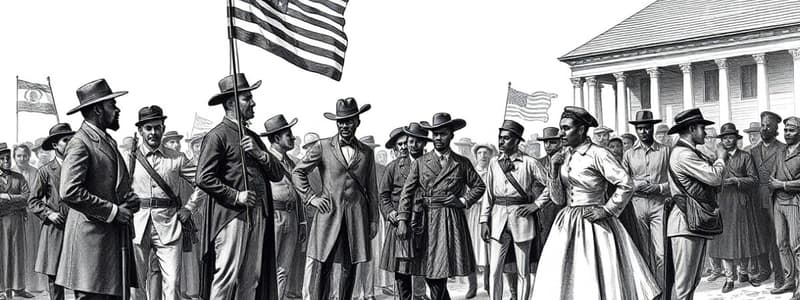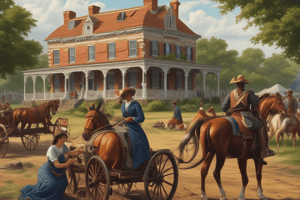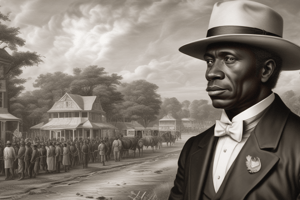Podcast
Questions and Answers
What did Kentucky Republicans support during the Reconstruction era?
What did Kentucky Republicans support during the Reconstruction era?
- Reconstruction in the South (correct)
- Opposition to the Thirteenth, Fourteenth, and Fifteenth Amendments
- The formation of the Democratic Party
- A return to pre-war conditions in Kentucky
How did Democrats in Kentucky generally view the constitutional amendments?
How did Democrats in Kentucky generally view the constitutional amendments?
- They opposed any movement toward extending black rights. (correct)
- They only opposed the Thirteenth Amendment.
- They supported all amendments wholeheartedly.
- They welcomed the amendments as progress.
What slogan did Republicans use to rally support during this period?
What slogan did Republicans use to rally support during this period?
- The Voice of the Oppressed
- Peace and Reconciliation
- The Party of Patriot Soldiers (correct)
- The Party of the Betrayed
Which influential group primarily made up the Kentucky Republican Party?
Which influential group primarily made up the Kentucky Republican Party?
What avenue did Democrats often appeal to in their political arguments?
What avenue did Democrats often appeal to in their political arguments?
In their political positioning, how did the Republican Party see themselves in comparison to the Democrats?
In their political positioning, how did the Republican Party see themselves in comparison to the Democrats?
What message did The Kentucky Gazette convey in its July 4, 1866, issue regarding voters' choices?
What message did The Kentucky Gazette convey in its July 4, 1866, issue regarding voters' choices?
What was the primary focus of Kentucky Democrats in their political strategy?
What was the primary focus of Kentucky Democrats in their political strategy?
What was the reaction of the audience towards the speaker's acknowledgment of his views?
What was the reaction of the audience towards the speaker's acknowledgment of his views?
In what year did Governor Stevenson first support black testimony?
In what year did Governor Stevenson first support black testimony?
What was the outcome of the proposed Fifteenth Amendment in January 1869?
What was the outcome of the proposed Fifteenth Amendment in January 1869?
How did the Kentucky General Assembly respond to the issue of black testimony after local judges were indicted?
How did the Kentucky General Assembly respond to the issue of black testimony after local judges were indicted?
What tactic did towns and cities use to reduce the number of black voters?
What tactic did towns and cities use to reduce the number of black voters?
What was the consequence of the increasing support for the Fifteenth Amendment among states?
What was the consequence of the increasing support for the Fifteenth Amendment among states?
What was the prevailing trend among blacks in their voting choices following the ratification of the Fifteenth Amendment?
What was the prevailing trend among blacks in their voting choices following the ratification of the Fifteenth Amendment?
What message was conveyed about future perspectives on the speaker's views?
What message was conveyed about future perspectives on the speaker's views?
What was a significant factor that divided the Republican party during this period?
What was a significant factor that divided the Republican party during this period?
Who was John Marshall Harlan?
Who was John Marshall Harlan?
What was the attitude of some voters in certain Democratic strongholds towards Republican candidates?
What was the attitude of some voters in certain Democratic strongholds towards Republican candidates?
What was the essence of the 'New Departure Democrats' that Harlan appealed to?
What was the essence of the 'New Departure Democrats' that Harlan appealed to?
What characterized the political scenario for African Americans in the elections?
What characterized the political scenario for African Americans in the elections?
Which of the following amendments were viewed as 'unconstitutional' by some factions?
Which of the following amendments were viewed as 'unconstitutional' by some factions?
What was the political affiliation of the majority of Republican candidates during this time?
What was the political affiliation of the majority of Republican candidates during this time?
What role did patronage play in the Republican party during this period?
What role did patronage play in the Republican party during this period?
Which candidate carried the highest percentage of votes in Kentucky during the 1868 race?
Which candidate carried the highest percentage of votes in Kentucky during the 1868 race?
What was one of the main focuses of the New Departure leaders?
What was one of the main focuses of the New Departure leaders?
What was the position of Governor Stevenson regarding federal Reconstruction policy?
What was the position of Governor Stevenson regarding federal Reconstruction policy?
What significant action did Governor Stevenson take against violence in Kentucky?
What significant action did Governor Stevenson take against violence in Kentucky?
Which statement accurately characterizes the role of Henry Watterson in Kentucky politics?
Which statement accurately characterizes the role of Henry Watterson in Kentucky politics?
What did the Bourbons refer to as the 'humiliation of this new departure'?
What did the Bourbons refer to as the 'humiliation of this new departure'?
What was William Campbell Preston Breckinridge's contribution to Kentucky politics during this period?
What was William Campbell Preston Breckinridge's contribution to Kentucky politics during this period?
What stance did Governor Stevenson take on black testimony in October 1866?
What stance did Governor Stevenson take on black testimony in October 1866?
What was the initial response of some white families in Kentucky regarding the loyalty of their slaves after the war ended?
What was the initial response of some white families in Kentucky regarding the loyalty of their slaves after the war ended?
What action did President Andrew Johnson take on October 12, 1865?
What action did President Andrew Johnson take on October 12, 1865?
What was the situation for some African Americans in Kentucky after the war, according to the content?
What was the situation for some African Americans in Kentucky after the war, according to the content?
What did the Kentucky Court of Appeals decide regarding the federal law on emancipation on December 15?
What did the Kentucky Court of Appeals decide regarding the federal law on emancipation on December 15?
What mobility did freedom bring to African Americans that was previously unknown under slavery?
What mobility did freedom bring to African Americans that was previously unknown under slavery?
What was a significant change for former slaves who chose to stay with white families after the war?
What was a significant change for former slaves who chose to stay with white families after the war?
What was one of the underlying issues for white Kentuckians after the departure of slaves?
What was one of the underlying issues for white Kentuckians after the departure of slaves?
What emotional state did the remaining slaves experience as they faced their uncertain status post-war?
What emotional state did the remaining slaves experience as they faced their uncertain status post-war?
What characterized the political situation in postwar Kentucky?
What characterized the political situation in postwar Kentucky?
Which party was prominent in Kentucky before the 1850s?
Which party was prominent in Kentucky before the 1850s?
Which groups were primarily a part of the new political landscape in postwar Kentucky?
Which groups were primarily a part of the new political landscape in postwar Kentucky?
What view did the opposition hold towards those branded as radicals in Kentucky?
What view did the opposition hold towards those branded as radicals in Kentucky?
What was the political stance of the Democratic Party in the aftermath of the Civil War?
What was the political stance of the Democratic Party in the aftermath of the Civil War?
What was the best-defined and most stable among the new political parties formed?
What was the best-defined and most stable among the new political parties formed?
What did the political changes in postwar Kentucky highlight about the Democratic Party?
What did the political changes in postwar Kentucky highlight about the Democratic Party?
Why was the Democratic Party referred to as 'the secession Democracy'?
Why was the Democratic Party referred to as 'the secession Democracy'?
Flashcards
Slavery in Kentucky
Slavery in Kentucky
Slavery, though legally abolished, persisted in Kentucky and caused considerable uncertainty and unrest in families.
Martial Law (Kentucky)
Martial Law (Kentucky)
Kentucky remained under military rule for five months after the Confederate surrender to maintain order and protect freed slaves.
Andrew Johnson's action
Andrew Johnson's action
President Andrew Johnson ended military rule in Kentucky on October 12, 1865, creating applause from white Kentuckians.
Legal status of freed slaves
Legal status of freed slaves
Signup and view all the flashcards
Kentucky Court of Appeals decision
Kentucky Court of Appeals decision
Signup and view all the flashcards
Freedom and Mobility
Freedom and Mobility
Signup and view all the flashcards
Uncertain working situation
Uncertain working situation
Signup and view all the flashcards
Continued Slavery (despite freedom)
Continued Slavery (despite freedom)
Signup and view all the flashcards
Postwar Kentucky Politics
Postwar Kentucky Politics
Signup and view all the flashcards
Political Readjustments (Kentucky)
Political Readjustments (Kentucky)
Signup and view all the flashcards
Three New Parties
Three New Parties
Signup and view all the flashcards
Union Party
Union Party
Signup and view all the flashcards
Conservative/Southern Rights Party
Conservative/Southern Rights Party
Signup and view all the flashcards
Republican Radicals (Kentucky)
Republican Radicals (Kentucky)
Signup and view all the flashcards
Antebellum Whig Party's Influence
Antebellum Whig Party's Influence
Signup and view all the flashcards
War's Effect on Politics (Kentucky)
War's Effect on Politics (Kentucky)
Signup and view all the flashcards
Republican Party's stance on Reconstruction
Republican Party's stance on Reconstruction
Signup and view all the flashcards
Democratic Party's approach to Reconstruction
Democratic Party's approach to Reconstruction
Signup and view all the flashcards
Waving the "bloody shirt"
Waving the "bloody shirt"
Signup and view all the flashcards
Kentucky Republicans' goals
Kentucky Republicans' goals
Signup and view all the flashcards
Democratic party strategy
Democratic party strategy
Signup and view all the flashcards
Former Unionists and Whigs in Republican Party
Former Unionists and Whigs in Republican Party
Signup and view all the flashcards
Kentucky Gazette's Role
Kentucky Gazette's Role
Signup and view all the flashcards
Republicans' view of the future
Republicans' view of the future
Signup and view all the flashcards
New Departure
New Departure
Signup and view all the flashcards
1868 Election
1868 Election
Signup and view all the flashcards
Bourbons
Bourbons
Signup and view all the flashcards
Governor Stevenson
Governor Stevenson
Signup and view all the flashcards
Kentucky Courier-Journal
Kentucky Courier-Journal
Signup and view all the flashcards
Henry Watterson
Henry Watterson
Signup and view all the flashcards
William Campbell Preston Breckinridge
William Campbell Preston Breckinridge
Signup and view all the flashcards
Reconstruction Policy
Reconstruction Policy
Signup and view all the flashcards
Black testimony in Kentucky courts
Black testimony in Kentucky courts
Signup and view all the flashcards
Fifteenth Amendment
Fifteenth Amendment
Signup and view all the flashcards
Kentucky's rejection of the Fifteenth Amendment
Kentucky's rejection of the Fifteenth Amendment
Signup and view all the flashcards
Black voting in Kentucky
Black voting in Kentucky
Signup and view all the flashcards
Republican Party's appeal to black voters
Republican Party's appeal to black voters
Signup and view all the flashcards
Subterfuges to limit black suffrage
Subterfuges to limit black suffrage
Signup and view all the flashcards
John Marshall Harlan
John Marshall Harlan
Signup and view all the flashcards
Political shifts in Kentucky post-Civil War
Political shifts in Kentucky post-Civil War
Signup and view all the flashcards
Post Office Republicans
Post Office Republicans
Signup and view all the flashcards
1871 Election
1871 Election
Signup and view all the flashcards
New Departure Democrats
New Departure Democrats
Signup and view all the flashcards
John Marshall Harlan
John Marshall Harlan
Signup and view all the flashcards
Republican Administration
Republican Administration
Signup and view all the flashcards
African American voting
African American voting
Signup and view all the flashcards
Republican Optimism
Republican Optimism
Signup and view all the flashcards
Kentucky House and Senate vote
Kentucky House and Senate vote
Signup and view all the flashcards
Study Notes
Kentucky Republicans During Reconstruction
-
Kentucky Republicans supported the principles of Reconstruction and believed in full civil rights for African Americans.
-
The Republican Party sought to counteract the Democratic Party's opposition to Reconstruction and their attempts to limit Black suffrage.
-
Kentucky Republicans used the slogan "The Union Must Be Restored" to rally their support, signifying their commitment to national unity and equality.
-
The Republican Party in Kentucky was primarily made up of African Americans, former Unionists, and some white reformers.
-
"The Union Must Be Restored" was used by the Republicans as a rallying cry to promote national unity, Reconstruction, and equality.
Kentucky Democrats During Reconstruction
-
Kentucky Democrats viewed the 13th, 14th, and 15th Amendments as "unconstitutional", arguing against federal authority and Black suffrage.
-
Democrats often appealed to regional interests and cultural anxieties in their political rhetoric.
-
Democrats referred to themselves as "the conservative Democracy," highlighting their opposition to the radical Reconstruction policies of the Republican Party.
-
Kentucky Democrats focused primarily on restoring white supremacy, opposing the extension of rights and political power to African Americans.
Public Perception and Political Landscape
-
Kentucky Gazette's July 4, 1866, issue cautioned voters against the "radical" changes brought by Reconstruction.
-
The Democratic Party was initially stronger in Kentucky, with its base of white landowners and conservative voters.
-
The Republican Party saw itself as defenders of national unity and equality for all, standing in opposition to the "narrow" views of the Democrats.
-
The audience generally supported the speaker's position, reflecting the prevailing sentiment against radical Reconstruction.
Black Testimony and Voting Rights
-
Governor Stevenson initially opposed allowing black testimony but changed his stance in 1866.
-
The proposed Fifteenth Amendment was rejected in January 1869, highlighting the ongoing resistance to Black suffrage.
-
The Kentucky General Assembly intervened after local judges were indicted for excluding Black testimony, ultimately upholding the legitimacy of Black testimony.
-
Kentucky towns and cities implemented strategies like poll taxes and literacy tests to disenfranchise Black voters.
-
Increased support for the Fifteenth Amendment across various states led to its eventual ratification.
-
After its ratification in 1870, African Americans largely voted Republican, aligning themselves with the party that championed their rights.
Political Divisions and the New Departure
-
Republican Party faced internal division during this period, with some factions opposing the radical Reconstruction policies.
-
John Marshall Harlan, a prominent Kentucky jurist, stood for equality and opposed racial discrimination.
-
Democratic strongholds saw voters rejecting Republican candidates due to their stance on African American rights.
-
Harlan's "New Departure" called for reconciliation and a shift away from the radical Reconstruction policies.
-
African Americans found themselves caught in the political struggles of Reconstruction, experiencing limited progress and ongoing discrimination.
Key Events and Notable Figures
-
The 13th, 14th, and 15th Amendments were viewed as unconstitutional by some anti-Reconstruction factions.
-
Republican candidates during this period were primarily former Unionists and African American leaders.
-
Patronage played a significant role in the Republican Party, sometimes leading to corruption and internal conflict.
-
Grant carried the highest percentage of votes in Kentucky during the 1868 presidential race.
-
New Departure leaders focused on reconciliation and a more moderate Reconstruction approach.
-
Governor Stevenson opposed federal Reconstruction policies, arguing for a state-led approach.
-
Governor Stevenson took action against violence in Kentucky, demonstrating his commitment to public order.
-
Henry Watterson, a prominent Kentucky journalist, used his influence to promote the Democratic Party and oppose Reconstruction.
-
The 'humiliation of this new departure' referred to the shift by some Democrats towards a more accommodating approach to African American rights.
-
William Campbell Preston Breckinridge was a prominent Kentucky politician who played a significant role in the political debates during Reconstruction.
-
Governor Stevenson finally supported black testimony in October 1866, reflecting a gradual change in his stance.
Slavery's End and its Aftermath
-
White families, initially unsure about the loyalty of their former slaves after the war, expressed mixed feelings.
-
President Johnson issued an amnesty proclamation on October 12, 1865, seeking reconciliation between the North and South.
-
Some African Americans, despite being freed, faced restrictions and economic challenges in Kentucky after the war.
-
The Kentucky Court of Appeals ruled on December 15, 1865 that federal law on emancipation was constitutional.
-
Freedom brought opportunities for relocation, employment, and self-determination to African Americans, previously restricted by slavery.
-
Former slaves, choosing to stay with white families, faced altered relationships and new dynamics.
-
The departure of slaves left white Kentuckians grappling with labor shortages and a shifting social landscape.
-
Remaining slaves experienced uncertainty and fear about their future after the war.
The New Political Landscape
-
Kentucky's political landscape during Reconstruction was marked by conflict, shifting alliances, and fierce debate.
-
The Whig Party had dominated Kentucky politics before the 1850s, but disintegrated after the war.
-
The new political landscape was dominated by the Democrats and the Republicans, each with their distinct ideologies.
-
Conservative voters viewed the "radical" Republicans as threatening and destructive to the established order.
-
The Democratic Party sought to regain control, advocating for white supremacy and limited Reconstruction.
-
The Republican Party emerged as the most defined and stable force, advocating for African American rights and national unity.
-
The changes in Kentucky politics after the war exposed the deep divisions within the Democratic Party.
-
The Democratic Party was labeled "the secession Democracy" due to their strong support for the Confederate cause during the war.
Studying That Suits You
Use AI to generate personalized quizzes and flashcards to suit your learning preferences.
Related Documents
Description
Explore the complex changes in race relations and politics in Kentucky following the Civil War. This quiz examines the impact of slavery's abolition, the unique challenges Kentucky faced, and the role of federal intervention in ensuring rights for Black people. Assess your understanding of this critical period in American history.



